Altacor
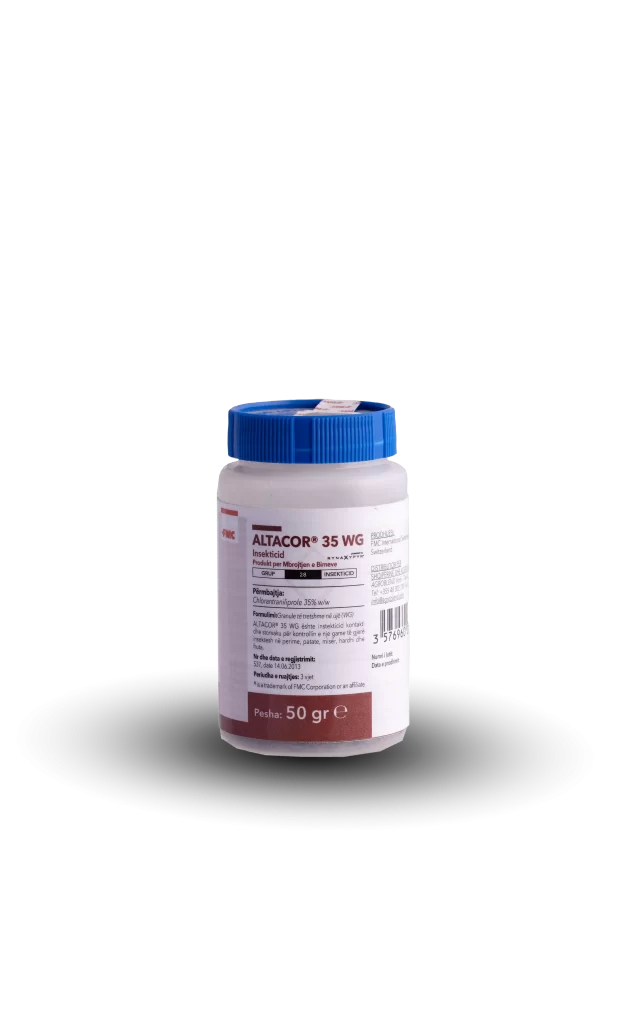
Agroblend Altacor 35 WG Home Insecticide Product Information on the product Formulation: Water-soluble granules (WG)Type: Granular insecticide for controlling a wide range of insects in vegetables, potatoes, corn, vines, and fruit trees. ALTACOR 35 WG is an insecticide that controls all larval stages, while the adult stages of some species are partially controlled. The activity occurs through ingestion and contact. Paralysis of the pest occurs within a few hours after exposure, resulting in the interruption of movement and feeding. Final control is achieved within 2-4 days. Please consult the technical service for advice on specific crops and conditions. Contact Now >> First aid instructions and advice for the doctor:Do not give anything by mouth to an unconscious person. Inhalation: Consult a doctor immediately for further medical advice. Skin contact: It is not expected to cause skin problems. However, in case of contact, wash immediately with plenty of water. If a person feels unwell or has skin irritation, consult a doctor. Eye contact: Keep eyes open and rinse carefully with plenty of water, including under the eyelids, for at least 15 minutes. Consult a specialist for advice on treatment. Ingestion: Seek medical attention immediately and show the label (S46). Information Characteristics ALTACOR 35 WG is a contact and stomach insecticide for controlling a wide range of insects in vegetables, potatoes, corn, vines, and fruits. It is used for controlling various lepidopteran pests in different crops, both in greenhouses and open fields. It contains chlorantraniliprole, a new anthranilic diamide insecticide with a unique mode of action. It acts by activating the ryanodine receptors of insects. It binds to the insect receptors, triggering the release and depletion of calcium from smooth and striated muscles, causing muscle regulation damage, paralysis, and ultimately the death of the insects. Chlorantraniliprole works through contact and ingestion. The behavior of the insect changes rapidly after exposure to a toxic dose of the active substance, resulting in a quick interruption of feeding, the insect’s death shortly thereafter, and thus providing excellent protection for the treated crop. Cleaning of spraying equipmentImmediately after application, completely empty the equipment. Rinse the spraying equipment thoroughly with clean water 3 times. Remove visible residues. Disassemble the spray nozzles, filters, etc., and clean them carefully. Do not clean near water surfaces. Dispose of the cleaning water according to applicable laws. PhytotoxicityAt the recommended doses and plants, no signs of phytotoxicity are observed. Environmental impactR50/53 – Very toxic to aquatic organisms; may cause long-term negative effects in the aquatic environment. Do not contaminate water with the product or its containers. Do not clean spraying equipment near surface waters. Avoid contamination through runoff.S61 – Avoid release into the environment. Withdrawal periodTable grapes 3 days; Wine grapes 28 days; Fruit trees 14 days; Vegetables 1 day. StorageStore in a dark, cool place and in the original packaging, at temperatures up to 40°C. Information Preparation ALTACOR 35 WG is an insecticide used for controlling various larval stages of Lepidoptera and Coleoptera species. It controls all larval stages, while the adult stages of some species are partially controlled. The activity occurs through ingestion and contact. The product also has ovilarvicidal efficacy against some important species. Paralysis of the pest occurs within a few hours after exposure, resulting in the interruption of movement and feeding. Final control is achieved within 2-4 days. Preparation of the solutionEnsure that the equipment is clean and functional. It dissolves quickly in water. Fill the tank halfway with water. Start mixing. Pour the required amount of the product directly into the tank. Continue mixing while filling the tank with the necessary amount of water, and during spraying. The prepared solution should be used within the day. If mixed with other products, carefully check the measures and restrictions. Information Precautionary Measures • S1/2 – Keep out of reach of children. • S13 – Keep away from food, drinks, and animal feed. • S20/21 – Do not eat, drink, or smoke while using. • If you do not feel well, seek medical attention immediately and show the label. • S36/37 – Wear appropriate protective clothing, protective gloves. • Wash thoroughly before eating and always after finishing work. • During application, avoid situations with strong wind. • Do not breathe in spray mist or vapors. • Do not apply this product in a manner that may result in contact with workers or other persons. • S57 – Use appropriate containers to avoid environmental contamination. • S60 – This material and its container must be disposed of safely. Information Usage & Dosage Crop Pest Dosage of Formulation (Gr/1000 m²) Dosage of Formulation (Gr/100 L) Volume of Spray Solution (lt/1,000 m2 ) Application Method and Timing Max Treatments per Season Vineyard Grape Vine Moth (Lobesia Botrana) 8-12 8-10 6-120 Spray at the onset of infection in the blackhead phase, ensuring the product is used before penetration into the grape. 2 Melon, Watermelon, Cucumber (greenhouse) Spodoptera littoralis, Spodoptera exigua, Helicoverpa armigera, Autographa gamma 8-14 (in greenhouse) 8-12 (in greenhouse) 50-120 (in greenhouse) Spray during egg hatching and before symptoms appear on new leaves. Maximum dosage is recommended against S. littoralis in cases of high infestation. Application interval: 7-14 days. 2 Lettuce (greenhouse and open field) Spodoptera littoralis, Spodoptera exigua, Helicoverpa armigera 8-12 8-12 (greenhouse and open field) 50-100 (greenhouse and open field) Spray during egg hatching and before symptoms appear on new leaves. Application interval: 7-14 days. 2 Tomato, Eggplant, Pepper Spodoptera littoralis, Spodoptera exigua, Helicoverpa armigera, Autographa gamma, Ostrinia nubilalis 10-12 10-12 (greenhouse and open field) For peppers: 8-10 (greenhouse and open field) 50 – 150 For peppers: 30 – 125 Spray during incubation before symptoms appear on new leaves. Application interval: 7-14 days. 2 Tomato (greenhouse and open field) Tuta absoluta 8-12 50-100 (greenhouse)20-100 (open field) Minimum dose 8 g/1000 m² Spray at the onset of infection. Application interval: 10-14 days. 2 Vineyard Pest: Grape Vine Moth (Lobesia Botrana) Dosage of Formulation (Gr/1000 m²): 8-12 Dosage of Formulation (Gr/100 L): 8-10 Volume of Spray Solution (lt/1,000 m²): 6-120 Application
Coragen
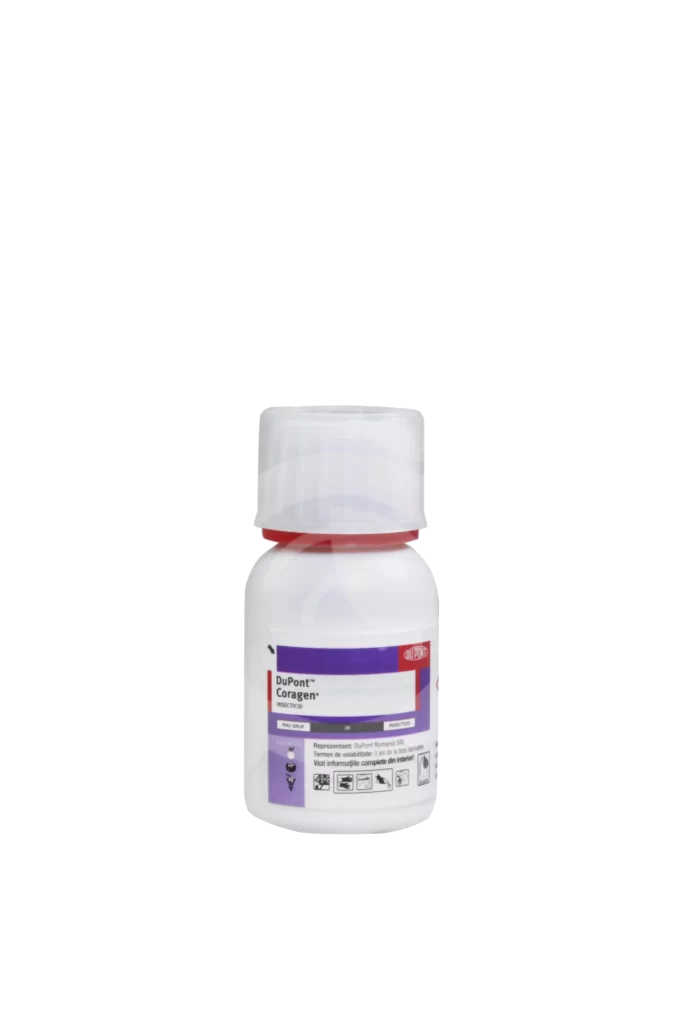
Agroblend Coragen 20 SC Home Insecticide Product Information on the product Type: Insecticide in the form of a suspension concentrateFormulation: Suspension concentrate (SC)Appearance: White-colored liquid Coragen is an insecticide used for controlling the larvae of various Lepidoptera and Coleoptera species. It controls all larval stages, and the adult stages of some species are partially controlled. The activity is through ingestion and contact. Please consult the technical service for advice on specific crops and conditions. Contact Now >> Personnel protection and hygieneDuring the transportation and use of Coragen, always wear a coverall, mask for the nose, face, gloves, and rubber boots. If you feel unwell, immediately seek medical help and show the label. Strictly follow the precautionary measures:• Do not eat, drink liquids, or smoke.• Wash thoroughly before eating and always after finishing work.• During application, avoid situations with strong winds.• Do not breathe in the vapors or spray mist.• Do not apply this product in a way that it may come into contact with workers or other people. First aid• Swallowing: Drink 1-2 glasses of water. Immediately inform a doctor. Do not induce vomiting. Never induce vomiting or give anything by mouth to an unconscious person or one with convulsions.• Skin contact: Remove contaminated clothing. Rinse immediately with plenty of water. If the person feels unwell or experiences skin irritation, consult a doctor.• Eye contact: Keep the eyes open and rinse them carefully with plenty of water, including under the eyelids, for at least 15 minutes. Consult a specialist for treatment advice.• Inhalation: Move the person to fresh air. If necessary, administer oxygen and perform mouth-to-mouth resuscitation, if possible. Consult a doctor for further medical advice. Information Additional Information Coragen works by activating the ryanodine receptors of insects. Coragen binds to insect receptors, triggering the release and depletion of calcium from smooth and striated muscles, causing regulatory muscle damage, paralysis, and ultimately the death of the insects. Chlorantraniliprole acts through contact and ingestion. Insect behavior rapidly changes after exposure to a toxic dose of the active substance, resulting in a quick interruption of feeding, the death of the insect after a short period, and thus providing excellent protection for the treated crop. Coragen is a suspension concentrate that can be applied as a foliar spray to control many major pests. Coragen is mixed with water for application. The product also has ovicidal and larvicidal effectiveness against some important species. Paralysis of the pest occurs within a few hours after exposure, resulting in the interruption of movement and feeding. Final control is achieved within 2-4 days. Stability against washingCoragen is stable as the sprayed solution dries within 1-2 hours. If it rains after the solution has dried, reapplication is not necessary. Field entry is allowed immediately after the solution has dried. Usage RestrictionsDo not use on plants stressed due to drought, excess water, low temperatures, nutrient deficiencies, or other factors that reduce plant growth.Do not use with drip or flood irrigation systems; do not use on turf or ornamental plants; do not use on hydroponic crops or those grown in containers. Do not apply directly to water or areas with surface water present; avoid contaminating water bodies and surfaces with the product solution or container residues. Resistance Management and PreventionWhen insecticides with the same mode of action are used repeatedly over several years in the same field, naturally less sensitive types of pests may survive and develop. An insect is considered resistant to an insecticide if it survives a proper treatment at the recommended dose and interval under normal conditions.Resistance development can be avoided or delayed by alternating or mixing products with different modes of action. Coragen is an insecticide of Group 28 (ryanodine receptor modulators) according to the IRAC mode of action scheme. Repeated use of Coragen or other Group 28 insecticides can lead to resistance in some insects on some crops. To prevent this, the number of Coragen applications is limited to two per season. It should also be part of an integrated pest management (IPM) program for the area of use, including biological control practices and insecticide rotation with different modes of action. Integrated Pest Management (IPM)DuPont supports the use of Integrated Pest Management (IPM) programs. This product can be used as part of an IPM program, which includes biological, cultural, and genetic practices aimed at preventing pest attacks. IPM principles and practices include field monitoring, correct identification of pests, monitoring pest populations, rotation of insecticides with different modes of action, and timely treatment. Consult with extension services or local professionals to determine the pest threshold for appropriate treatment in your area. Beneficial ArthropodsCoragen helps protect a wide range of beneficial arthropods (parasitoids and predators). While these beneficial arthropods may not control all pests, they are valuable allies and can be monitored alongside pests in management programs for these crops.According to Good Agricultural Practices standards, Coragen should not be used when bees are active.DO NOT APPLY WHEN BEES ARE PRESENT, OR DURING THE FLOWERING STAGE. SPRAY EARLY IN THE MORNING OR LATE IN THE EVENING WHEN BEE ACTIVITY IS MINIMAL. Storage, Transport, and DisposalStore in a locked, dry, cool, and well-ventilated area, away from food, beverages, and animal feed, and away from excessive moisture, heat, direct sunlight, and flammable materials. In case of spillage, collect the spilled product and dispose of it according to regulations. Do not use/store in domestic environments. Do not store at temperatures below 0°C. Information Usage & Dosage Instructions for UseApply at the recommended rates when insect populations reach the economic threshold set locally. Consult with local agronomic services, professional advisors, or other qualified authorities to determine the appropriate treatment level for your area. For most crops, foliar applications of Coragen should be applied at intervals of 10 to 14 days to maintain control. Monitor insect populations to determine whether application with Coragen is necessary, based on the economic threshold set locally. More than one application of Coragen may be needed to control a pest population. Apple/Pear: To control Cydia pomonella (Linnaeus), apply
LOS OVADOS 200 SE
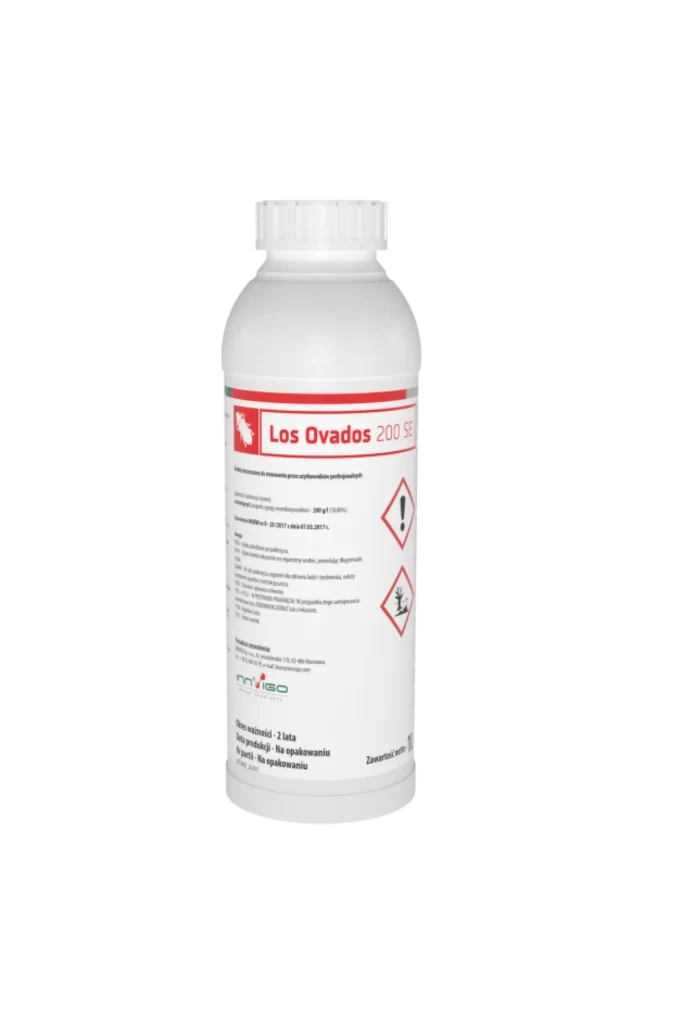
Agroblend Los Ovados 200 SE Home Insecticide Product Information on the product Formulation: Suspended Emulsion (SE) LOS OVADOS 200 SE is an insecticide with contact and stomach action, aimed at controlling sucking and biting insects. The product has contact, translaminar, and systemic effects on plants. In accordance with the IRAC classification, the active substance, acetamiprid, is classified as group 4A. Please consult the technical service for advice on specific crops and conditions. Contact Now >> First aid instructions and advice for the doctor: H302: Harmful if swallowed. In case of swallowing, contact with the respiratory organs and skin may cause the following symptoms: eye irritation, muscle spasms, dyspnea, cyanosis, possible ataxia, bradycardia.H410: Very toxic to aquatic life with long-lasting effects.H361d: Suspected of damaging fertility or the unborn child. In case of contact with skin or mucous membranes, wash thoroughly with plenty of water and soap. In case of inhalation of the spray solution with respiratory organs, place the affected person in a warm and well-ventilated environment. In case of poisoning, immediately seek assistance at the nearest hospital, showing the doctor the product label. If swallowed: Call a poison center or doctor if you feel unwell. Rinse your mouth. If medical advice is needed, have the container or product label at hand. No specific antidote is known. Treatment should be symptomatic.Antidote: None, treated symptomatically. Information Characteristics Note: The product contains the active substance acetamiprid – a neonicotinoid component (insecticides that interact with nicotine acetylcholine receptors (Ach) – IRAC group 4A). To minimize the risk of insect resistance, the following recommendations should be followed: the product should only be used at the recommended doses and periods, the recommended number of treatments per season should not be exceeded, and if additional treatments are necessary, a product with an active ingredient from a different group and with a different mode of action should be used. Solution preparation: Before starting to prepare the solution, carefully determine the required volume along with the amount of product. When filling the sprayer, follow the sprayer manufacturer’s instructions. In the absence of instructions, add the measured amount of product to the sprayer tank, which should be partially filled with water (with the mixer running). Rinse the empty containers three times with water and pour them into the sprayer tank along with the solution. Add water to the required amount and mix well. After pouring the product into a sprayer tank that does not have a hydraulic mixer, mix the solution mechanically. In case of interruption in spraying, thoroughly mix the solution in the sprayer tank before resuming spraying. Clean the equipment thoroughly after use. Phytotoxicity: No signs of phytotoxicity are observed at the recommended doses and plants. Usage Warning: The product should not be used on alkaline soil for the production of winter rapeseed, spring rapeseed, and potatoes. Spraying on insects (especially sucking insects) should be complete, covering all parts of the plant with the spray solution. The product should be used at temperatures below 20°C. At higher temperatures, the treatment should be carried out at the end of the day. Impact on the Ecosystem:EUH401: To avoid risks to human health and the environment, follow the usage instructions. EUH208: Contains 1,2-benzisothiazol-3(2H)-one. May cause an allergic reaction. Do not contaminate water with the product or its packaging. Do not wash equipment near surface waters. Avoid contamination of watercourses from farms and roads. Prevent spills into the environment. During the flowering period of different crops, it is recommended to use the agent outside the bee activity periods. Do not use the product on alkaline soil. Maintain a buffer zone of at least 2-3 meters from residential buildings/inhabitants and third parties during field sprayer application and at least 5 meters during tree sprayer application. To protect aquatic organisms, it is necessary to establish a buffer zone of 20 meters from water reservoirs and water passageways. To protect other plants and arthropods, maintain an untreated buffer zone of 5 meters from non-agricultural land, or 1 meter from non-agricultural land, simultaneously taking measures to reduce the drift of the spray liquid by 90% during the treatment. Pre-harvest Interval: All intervals between the last application of the product and the day when the crop is harvested (waiting period): Potatoes: 7 days Rapeseed: 39 days Apples, cherries, sour cherries, walnuts, hazelnuts, pears, plums, nespuls, quinces: 14 days Tomatoes, peppers, and eggplant in greenhouses: 3 days Safety Period for Entry: The period between the application of the product and the day when people and animals can enter the treated area (preventive period): 1 day. Storage Conditions: Keep the plant protection product in its original packaging, at a temperature between 0°C and 30°C. Information Usage & Dosage Potatoes: against the Colorado potato beetle (Leptinotarsa decemlineata). The recommended dose for a single use is 0.1-15 liters/ha, diluted in 200-300 liters of water. Treatment should be carried out when eggs are detected and larvae begin to hatch in large numbers, from the 50% row coverage stage until full flowering (50% of flowers in the first bloom are open) (BBCH 35-65). Use the higher recommended doses in case of a mass outbreak. Apply 1 treatment/season. Apples and pears: against aphids (Aphis spp., Dysaphis plantaginea). The maximum recommended dose for a single use is 0.125 liters/ha, diluted in 700-750 liters of water. Apply when the first aphid colonies appear. Perform treatment from the end of the flowering stage until fruit reaches 10 mm in size (BBCH 69-71). Against codling moth (Cydia pomonella): The maximum recommended dose for a single use is 0.2 liters/ha, diluted in 700-750 liters of water. Treat at the beginning of pest flight and mass egg-laying, at the end of the flowering phase, until the fruit diameter reaches 40 mm, as the fruit grows (BBCH 69-74). Apply 1-2 treatments/season, with a 30-day interval. Cherries, sour cherries: against fruit flies (Rhagoletis cerasi), apply the product when flies appear in large numbers and lay a significant number of eggs. Perform the treatment from when the fruit reaches 90% of its
Delegate
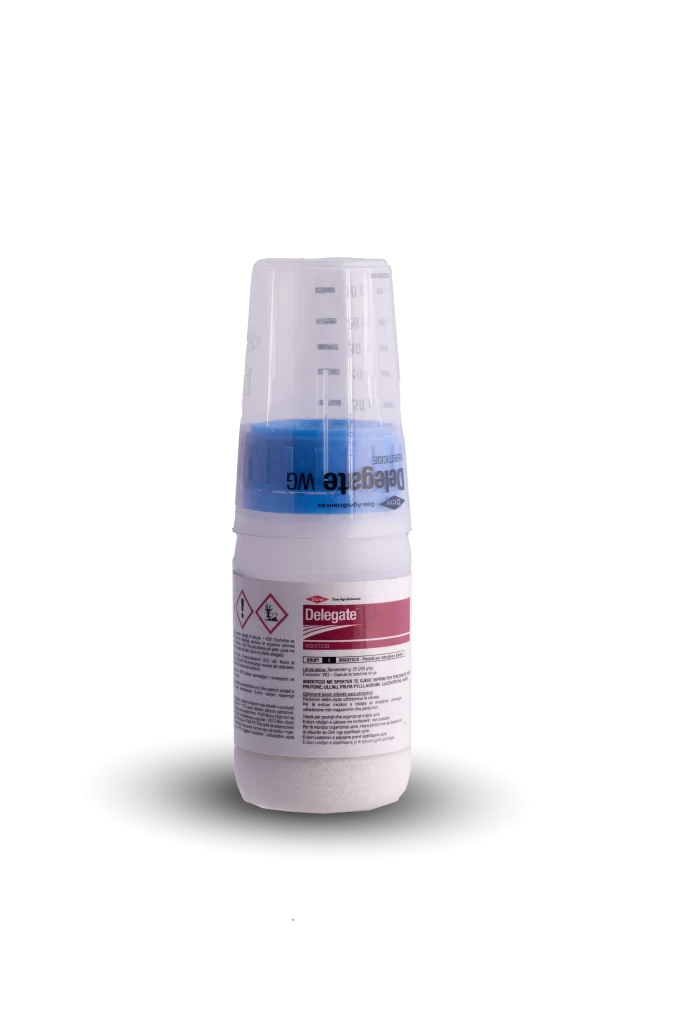
Agroblend Delegate Home Insecticide Product Information on the product Formulation: Water-soluble granules (WG) Insecticide with a broad spectrum of action for use on fruit trees, olive trees, forest fruits, citrus, strawberries, and vineyards. Please consult the technical service for advice on specific crops and conditions. Contact Now >> First Aid Instructions and Medical Advice:H317: May cause an allergic skin reaction.H361: Suspected of damaging fertility.H373: May cause organ damage through prolonged or repeated exposure.EUH208: Contains spinetoram and 1.2-benzisothiazol-3(2H)-one. May cause an allergic reaction. In case of inhalation: Move the person to fresh air.In case of breathing cessation: Call emergency services or an ambulance, then administer artificial respiration. To perform mouth-to-mouth resuscitation, the rescuer should use proper protection (e.g., a pocket mask).In case of skin contact: Immediately remove contaminated clothing. Rinse immediately with plenty of water for 15-20 minutes.In case of eye contact: Keep the eyes open and rinse slowly and gently with water for 15-20 minutes. Remove contact lenses, if present, after the first 5 minutes and continue rinsing the eyes. P101: If medical advice is needed, keep the container or label of the product nearby.P308-P313: If exposed or concerned: Immediately call a poison center or doctor.There is no specific antidote. Symptomatic treatment. Information Characteristics Warning for Use:In areas with historically high infection levels, include the product in a specific pest control program. Compatibility: The product should be used alone. If mixed with other formulations, the longest waiting period should be observed. Calibrate sprayers to spray only from a short distance. Do not apply when wind speed exceeds 15 km/h. When used in high temperatures, calibrate sprayers to release larger droplets to avoid rapid evaporation.To reduce the likelihood of resistance phenomena, the product should be part of a strategy that alternates between spinetoram and spinosad products with others that have different mechanisms of action. Do not perform more than two treatments per season. Strictly adhere to the doses indicated on the label. Treat in the absence of wind. Phytotoxicity:When used alone, the product does not show phytotoxicity issues. Environmental Impact:H410: Very toxic to aquatic life with long-lasting effects. Avoid contaminating water with the container or product. To protect aquatic organisms, do not use within 20 meters of water bodies. Avoid cleaning equipment near water surfaces.P273: Do not pollute the environment.P391: Collect spilled product.P501: Dispose of product/container according to local regulations.SP1: Do not contaminate water with the product or its container.P501: Dispose of contents/container in accordance with national legislation. Do not clean spray equipment near surface water. Avoid pollution through drainage systems. Pre-harvest Intervals:3 days for citrus fruits, cherries, and sour cherries. 7 days for apples, pears, quinces, wild apples, medlar, peaches, nectarines, apricots, plums, figs, blueberries, persimmons, grapes, strawberries, blueberries, raspberries. 14 days for strawberries. 21 days for olives. Storage Conditions:Store the product in closed containers, in dry and cool places. Do not exceed a storage temperature of 35°C. The product should not be stored in direct sunlight or humidity. Information Usage & Dosage Usage:Delegate is based on spinetoram, an active ingredient derived from a bacterium (Saccharopolyspora spinosa), present in the soil and later chemically modified. It is used to control various leaf-feeding pests, including lepidopterans, thrips, leaf miners, and some psyllids that infect different crops. • In apples, pears, quinces, medlar, persimmons, pomegranates, figs: Treatments per season allowed, with an interval of 7-14 days. For Cydia pomonella, treat at egg hatch with 300-400 gr/ha. For Pandemis spp., Argyrotaenia pulchellana, Archips spp., Adoxophyes spp., treat when eggs hatch or against overwintering larvae with 300-400 gr/ha. For peach fruit moth (Cydia molesta), treat near harvest period with 300-400 gr/ha. For Leucoptera scitella, Phyllonoricter spp., treat at the first egg hatch with 350-400 gr/ha. For Psylla pyri, treat in the presence of the pest during the yellow egg phase with 400 gr/ha. The product has a good effect against Cacopsylla melanoneura, which may be present at the time of treatment against the main pests. • In peaches, nectarines, apricots, plums, cherries, sour cherries: 2 treatments per season allowed, with a 28-day interval. For peach fruit moth, Anarsia lineatella, and Cydia funebrana, treat at egg hatch with 300-400 gr/ha. For thrips (Thrips meridionalis, Thrips major, Frankliniella occidentalis), treat at the first appearance of the pest with 300-400 gr/ha. For the Asian fruit fly (Drosophila suzukii), treat at the appearance of the pest with 300-400 gr/ha. The product has a good side effect against Ceratitis capitata. • In olive trees: 2 treatments per season allowed, with a 28-day interval. For olive fruit fly (Prays oleae) and Philaenus spumarius, treat in the presence of the pest with 75 gr/ha. • In citrus fruits: 2 treatments per season allowed, with 300-400 gr/ha, in intervals of 7-14 days. For psyllids, leaf miners, leaf rollers, citrus thrips (Scirtothrips citri), use 800 gr/ha/season. Do not use in citrus in greenhouses. • In grapevines: 2 treatments per season allowed. For grapevine moth and thrips, treat at egg hatch with 250-300 gr/ha. • In pistachios: 1 treatment per season allowed. For Agonoscena sp., treat at pest appearance with 100 gr/ha. • In strawberries, blackberries, blueberries, raspberries: 2 treatments per season allowed. The doses are based on a solution of 1200-1500 liters/ha. For Cydia pomonella, treat at egg hatch with 300-400 gr/ha. For Pandemis spp., Argyrotaenia pulchellana, Archips spp., Adoxophyes spp., treat when eggs hatch with 300-400 gr/ha. For peach fruit moth, treat near harvest period with 300-400 gr/ha.For all crops, use 1000-1500 liters of solution/ha. Information Precautionary Measures • P102: Keep out of reach of children. • P103: Read the label before use. • P201: Obtain special instructions before use. • P202: Do not treat until all safety warnings are read and understood. • P281: Wear protective clothing. • P405: Store locked up. • EUH401: To avoid risks to human health and the environment, follow the instructions for use. Information Active Ingredients Active Ingredients Spinetoram 25 g (250 g/kg) Information Compatibility The product should be used alone. If mixed with other formulations, the longest waiting period should be observed. Calibrate sprayers
Closer
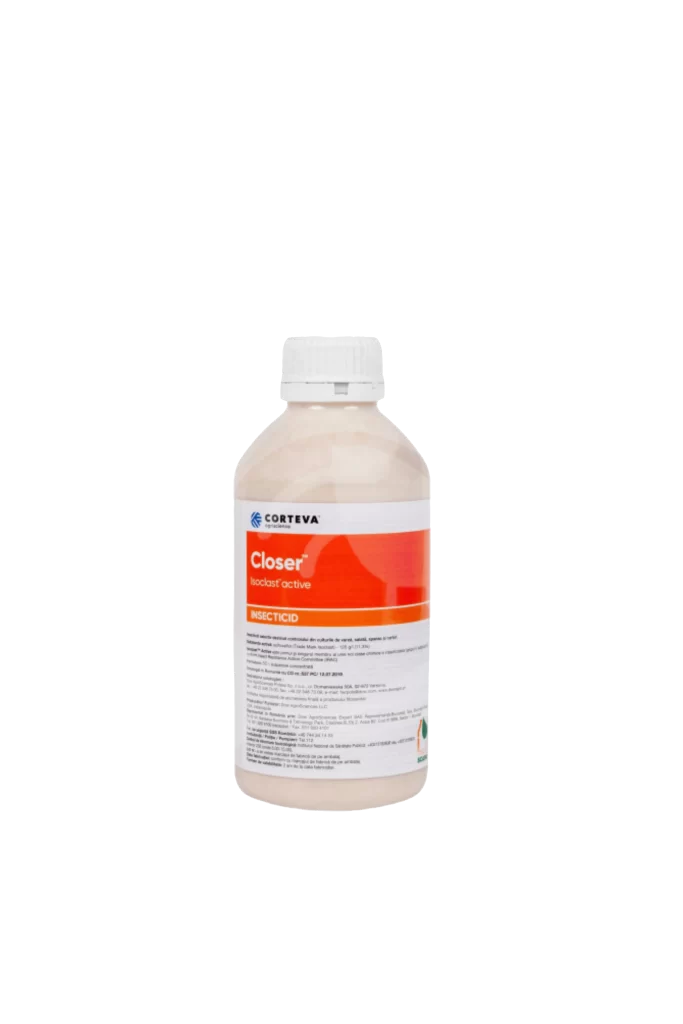
Agroblend Closer Home Insecticide Product Information on the product Type: Insecticide with a broad spectrum of action Closer® is a systemic insecticide that moves through the xylem with a translaminar movement and acts on insects primarily through contact and ingestion. Please consult the technical service for advice on specific crops and conditions. Contact Now >> First aid instructions and medical advice: EUH208: Contains 1,2-benzisothiazolin-3-one. May cause an allergic reaction. • In case of inhalation: Move the person to fresh air. • If breathing stops: Call emergency services or an ambulance immediately, then provide artificial respiration. When performing mouth-to-mouth resuscitation, the rescuer should use appropriate protection (e.g., a pocket mask). • In case of skin contact: Remove contaminated clothing immediately. Rinse the skin thoroughly with plenty of water for 15-20 minutes. • In case of eye contact: Keep the eyes open and rinse slowly and gently with water for 15-20 minutes. Remove contact lenses, if present, after the first 5 minutes, and continue rinsing the eyes. • In case of ingestion: No urgent medical treatment is necessary. Warning:P308-P313: If exposed or concerned: Immediately call a poison control center or a doctor/physician and provide the product label. Information Additional Information Usage:CLOSER is a systemic insecticide that moves through the xylem with translaminar action and acts on insects primarily through contact and ingestion. Contact occurs via direct application of the product. Ingestion happens through the stylet (feeding tube), which penetrates the plant’s vascular system. Once inside the insect’s body, Closer acts on the nicotinic acetylcholine receptor. Symptoms appear within a few hours, with mortality occurring shortly thereafter. Phytotoxicity:Not phytotoxic to authorized crops and recommended doses as indicated on this label. Usage notes:Do not use the product on fruit trees during the flowering period. Impact on the ecosystem:For applications on other crops, do not place the product near beehives or when bees are fully active in the crops to be treated. The product is hazardous to bees and should not be used in areas where bees forage. Treatments should be carried out during pre-activity or post-activity hours of bees. Avoid direct exposure of bees to the product during application, relocation, or when product residues are still wet. Environmental precautions: H411: Very toxic to aquatic life with long-lasting effects. To protect aquatic organisms, do not use within 20 meters of water surfaces. Avoid contaminating non-target surfaces during spraying. P273: Do not release into the environment. To avoid environmental contamination risks, follow storage and usage guidelines. SP1: Do not contaminate water with the product or its container. Do not clean spraying equipment near surface waters. Avoid contamination through drainage systems. P501: Dispose of the contents/container in accordance with local legislation. Pre-harvest interval:7 days for apple, pear, quince, medlar, peach, nectarine, cherry, sour cherry, jujube, citrus, lemon, potato, lettuce, brassicas, turnip. 1 day for tomato, pepper, eggplant, and cucurbits. Information Usage & Dosage For apples, pears, quinces, medlar: A maximum of 2 treatments per season are allowed, at intervals of 7-14 days. -Against apple aphids, bean aphids, rose aphids, green aphids on citrus, apply 200-400 ml/ha; -400 ml/ha against cotton aphid; -300 ml/ha against green peach aphid and cherry aphid, and 200 ml/ha against other aphids. -For California red scale, during the nymph migration period, perform 1 treatment with 400 ml or 2 treatments with 200 ml/ha each. Use up to 400 ml product/season. For peaches, nectarines, apricots, plums, cherries, sour cherries:2 treatments per season are allowed, at intervals of 7-14 days. -Against aphids, apply when the first infection appears and during the ripening phase, using 200-400 ml product/ha; -400 ml/ha against cotton aphid; -300 ml/ha against green peach aphid and cherry aphid; -200 ml/ha against other aphids. -For California red scale, perform 1 treatment with 400 ml or 2 treatments with 200 ml/ha each. Treat after flowering and during advanced fruit ripening, and always during nymph migration. Use up to 400 ml product/season. For citrus: 2 treatments per season are allowed, at intervals of 7-14 days. -Against aphids on citrus, California red scale, mealybug on citrus, green aphid on citrus, cotton aphid, and gourds, after the insect appears in the early phases and during the advanced ripening phase, use 400 ml product/ha in a single treatment or 2 treatments of 200 ml/ha each. Use up to 400 ml product/season. For tomatoes, peppers, eggplants, okra, in open fields and greenhouses: 2 treatments per season are allowed, at intervals of 7-14 days. – Against green peach aphid, aphids on cucurbits, potato aphid, apply at the first appearance of insects and during fruit ripening with a dose of 200 ml product/ha at a 7-day interval. Against tobacco whitefly and thrips, apply at the first appearance of insects, between the first shoot and fruit ripening, with a dose of 200 ml/ha. – In case of high infection, perform a single treatment with 400 ml/ha. Use up to 400 ml product/season. For cucurbits, in greenhouses and open fields: 2 treatments per season are allowed, at intervals of 7-14 days. – Against aphids on cucurbits, green peach aphid, bean aphid, apply when insects appear in early stages, between the first shoot and fruit ripening, with 200 ml/ha. – Against tobacco whitefly and thrips, apply at the first appearance of insects, between the first shoot and fruit ripening, with 200 ml/ha. – In case of high infection, perform a single treatment with 400 ml/ha. Use a maximum dose of 400 ml product/ha/season. For potatoes: 2 treatments per season are allowed, at intervals of 21 days. – Against green peach aphid, bean aphid, potato aphid, rose aphid, apply at the first appearance of insects, between the formation of lateral basal shoots and leaf yellowing, using 200 ml/ha. Use up to 400 ml product/season. For leafy vegetables: Only one treatment is allowed in open fields. – Against green peach aphid, apply at the first appearance of insects, between the ninth true leaf and the typical final height, with 200 ml/ha. Use a maximum of 200 ml product/ha/season. Given the large number of varieties in
Gure Kali 98-99%
Agroblend Gurë Kali 98-99% Home Fungicide Product Information on the product Active Ingredient: Copper sulfate 98-99% in crystalline form Can be used concentrated or mixed with lime in the form of Bordeaux paste. Usage:– Winter treatment for all crops– Fungicide for various fungal diseases– Can be used concentrated or mixed with lime– Very high solubility without residue Contact Now >> Agroblend Check out our product catalog! For a list of all the products & information on their usage. Click here to view >> Tap here to view >> Agroblend Other Products Alial 80 WP Olive Gold (22-6-12 +0.3 Bor) suluSOP 52% Take Up
Paste Bordoleze 20%
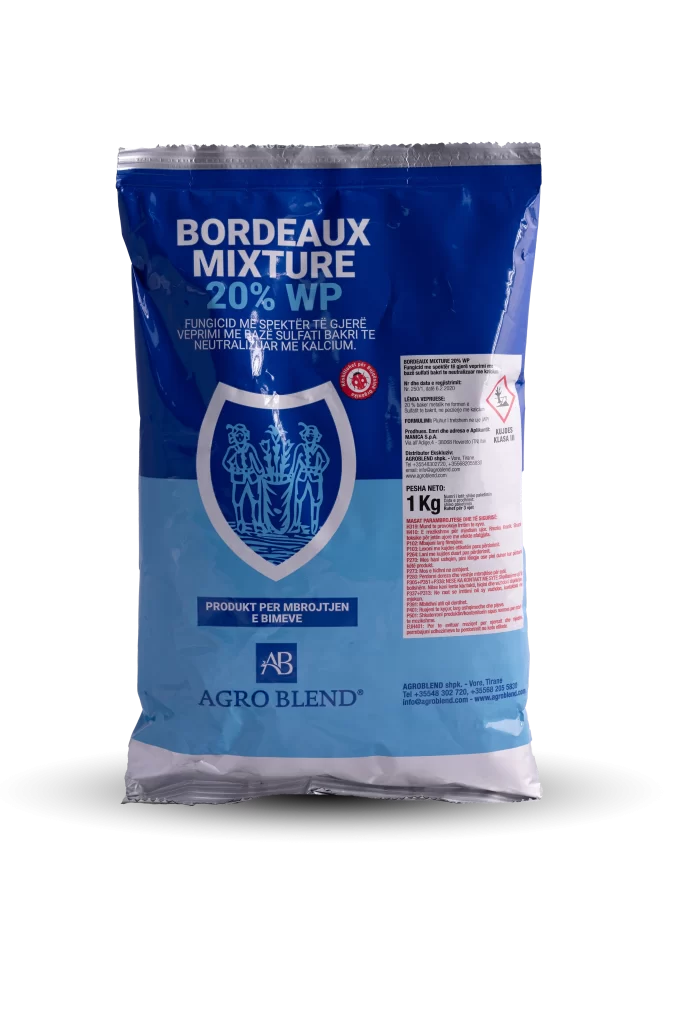
Agroblend Bordeaux Mixture 20% Home Fungicide Product Information on the product Weight: 1kgFormulation: Water-soluble powder (WP)Type: Contact fungicide with preventive and curative action Bordeaux mixture is a broad-spectrum contact fungicide used as a preventative against a wide range of fungal diseases sensitive to copper. Thanks to its special formulation and the perfect copper-calcium combination, the product is ideal for ensuring uniform coverage for the crops where it will be used. Please consult the technical service for advice on specific crops and conditions. Contact Now >> First aid instructions and medical advice: • H318: Causes serious eye damage. P305 + P351 + P338: IN CASE OF EYE CONTACT: rinse with plenty of water and soap for several minutes; remove contact lenses and rinse thoroughly. • In case of skin or mucous membrane contact: rinse with plenty of water and soap. • In case of inhalation of spray solution with respiratory organs: move the affected person to a warm and ventilated area. • P310: Seek immediate medical attention or go to an anti-poison center. THERAPY: Stomach lavage with milk and egg whites, and in cases of high copper levels, use gel-forming substances like penicillamine orally or CaEDTA and BAL intramuscularly. Information Additional Information PhytotoxicityDo not apply during blooming. This product may be phytotoxic to crops not mentioned on this label. On peach, apricot, and certain apple varieties (Abbondanza, Belfort, Black Stayman, Golden Delicious, Gravenstein, Jonathan, Rome Beauty, Morgenduft, Stayman, Stayman Red, Stayman Winesap, Black Davis, King David, Renetta del Canada, Rosa Mantovana) and pear varieties (Abate Fetel, Buona Luigia d’Avranches, Butirra Clairgeau, Passacrassana, B.C. William, Dott. Jules Guyot, Favorita di Clapp, Kaiser, Butirra Giffard), which are sensitive to copper, Bordeaux mixture can be phytotoxic if used during rapid vegetative growth. In such cases, non-use is recommended. Environmental Impact:H410: Very toxic with long-lasting effects on aquatic organisms.P273: Avoid release into the environment. Do not pollute waterways, ditches, or ponds with the spraying solution or packaging.P391: Collect spillage. Waiting Period (Pre-Harvest Interval):• 3 days for strawberries, potatoes, tomatoes, eggplants, root vegetables, bulb vegetables, cucurbits.• 7 days for leafy crops and fresh herbs.• 40 days for stone fruits.• 20 days for other crops. Storage:Store in the original containers in dry, ventilated areas at temperatures between 0°C and 35°C. Information Usage & Dosage Usage:Bordeaux mixture is a broad-spectrum contact fungicide used as a preventive measure against a wide range of fungal diseases sensitive to copper. Thanks to its special formulation and the perfect copper-calcium combination, the product ensures uniform coverage for crops where it will be applied. Solution Preparation:Dissolve the required amount of product in a small quantity of water, then pour it into the tank filled with the necessary amount of water, mixing continuously. The product is neutralized, and no lime should be used. Bordeaux mixture should be applied according to the calendar norms for control, with intervals of 7-12 days, depending on temperature and humidity conditions. During seasons with heavy rainfall, larger doses and shorter treatment intervals should be used.It is compatible with main antiparasitics, especially with sulfur formulations. Usage Notes & Compatibility:Treated seeds that have been in excess after sowing should not be used as food for humans or animals. Do not apply against the wind. In case of mixing with other formulations, the longest waiting period should be followed. Also, carefully observe the guidelines for products with higher toxicity. Please consult the technical service for additional advice on compatibility. CAUTION:It should be used only in agriculture; any other use may be dangerous. Following the instructions is essential to ensure treatment effectiveness and avoid damage to plants, humans, or animals. Information Precautionary Measures Precautionary Measures: • Keep in a safe place out of reach of children. • Store in a dry, cool place, away from food and beverages for humans, as well as animal feed. • Avoid prolonged contact of eyes and skin with the product. • Avoid inhalation of the product while preparing the spraying solution and during spraying. • Do not eat, drink water, or smoke during use. • P280: Wear gloves, appropriate work clothes, goggles, and a face mask. • After finishing the work, wash protective equipment and spraying tools. • After completing the task, wash hands and exposed body parts. • EUH401: To avoid risks to human health and the environment, follow the usage instructions. • P501: Dispose of containers in accordance with the current regulations. Information Active Ingredients Active Ingredients 20% metallic copper in the form of copper sulfate, blended with calcium Information Usage & Dosage Crop Parasites Time of Use Dosage Vine Downy mildew, anthracnose, black rot, secondary action against Botrytis – treatments before flowering – treatments after flowering – treatments for closure 600-700 g/hl 700-1000 g/hl 800-1000 g/hl Pome fruits (Apple, pear, fig) Scab, monilinia, septoria, branch canker, alternaria – treatments in autumn – treatments before flowering – treatments after flowering 800-1600 g/hl 700-1000 g/hl 800-1000 g/hl Olive Peacock eye, anthracnose, and other bacterial diseases Treatments at the end of winter 800-1200 g/hl Kiwi Neck rot 10-15 liters of solution based on the trunk 800-1200 g/hl Strawberries Powdery mildew, rot, anthracnose Vegetative start 500-1000 g/hl Rice Green algae As soon as the first signs appear 6-10 kg/ha Crop: Vine Parasites: Downy mildew, anthracnose, black rot, secondary action against Botrytis Time of Use: Treatments before flowering, after flowering, and for closure Dosage: 600-700 g/hl, 700-1000 g/hl, 800-1000 g/hl Crop: Pome fruits (Apple, pear, fig) Parasites: Scab, monilinia, septoria, branch canker, alternaria Time of Use: Treatments in autumn, before flowering, and after flowering Dosage: 800-1600 g/hl, 700-1000 g/hl, 800-1000 g/hl Crop: Olive Parasites: Peacock eye, anthracnose, and other bacterial diseases Time of Use: Treatments at the end of winter Dosage: 800-1200 g/hl Crop: Kiwi Parasites: Neck rot Time of Use: 10-15 liters of solution based on the trunk Dosage: 800-1200 g/hl Crop: Strawberries Parasites: Powdery mildew, rot, anthracnose Time of Use: Vegetative start Dosage: 500-1000 g/hl Crop: Rice Parasites: Green algae Time of Use: As soon as the first signs appear Dosage: 6-10 kg/ha Agroblend Check out
Sulfolac 80 WG
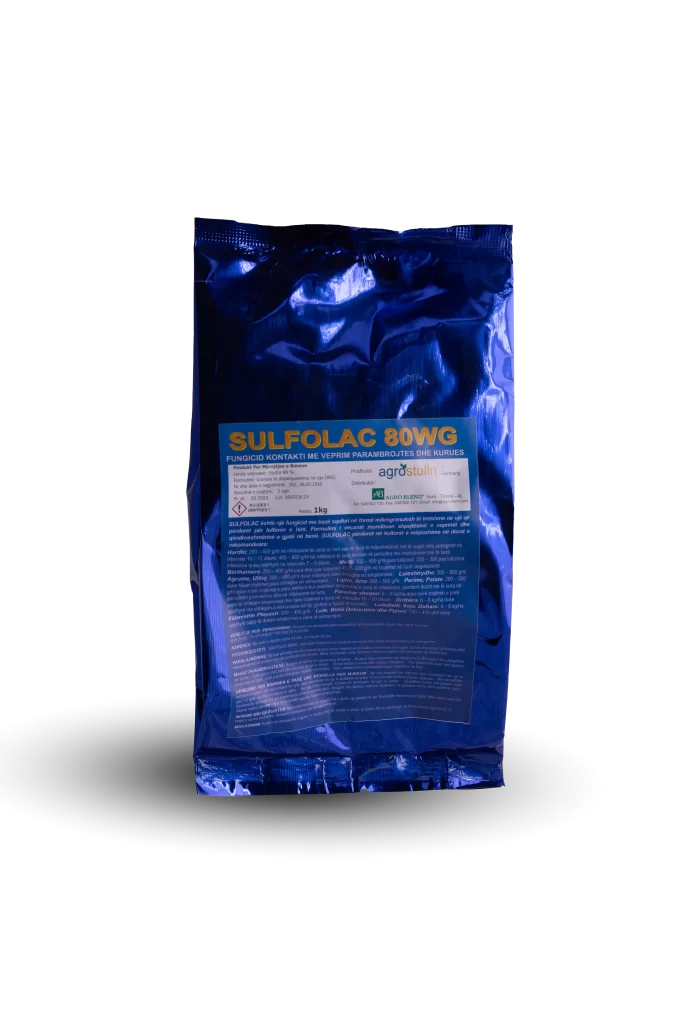
Agroblend Sulfolac 80 WG Home Fungicide Product Information on the product Weight: 1kgFormulation: Water-dispersible granules (WG).Appearance: Brown granules.Type: Contact fungicide with preventive and curative action SULFOLAC is a sulfur-based fungicide in the form of water-dispersible microgranules, used for fighting powdery mildew. The special formulation enables fast action and long-lasting stability on plants. Please consult the technical service for advice on specific crops and conditions. Contact Now >> First aid instructions and medical advice: • In case of skin contact, wash immediately with plenty of water and soap. • In case of eye contact, rinse immediately with plenty of water for at least 15 minutes and seek medical help. • In case of ingestion, drink 1-2 glasses of water and induce vomiting. • In case of inhalation of vapors, move the affected person to fresh air. • If unconscious, perform artificial respiration, and when breathing is difficult, administer oxygen and seek medical help at the nearest hospital, showing the doctor the label. • No specific antidote is known. Symptomatic treatment Information Additional Information Warnings for use:Mix with commonly used plant protection products, excluding those with alkaline reactions and mineral oils. Impact on the ecosystem:• Not harmful to aquatic organisms. Do not contaminate water bodies, watercourses, the spray solution, or empty packaging.• Not harmful to bees. Phytotoxicity:Not phytotoxic when used at the recommended doses and as per the instructions above. Withholding period:• For apples and pears: 14 days• For grapevines: 56 days. Storage:Keep in the original packaging, tightly closed, in dry, dark, and ventilated areas, at temperatures between 10-30°C. Information Usage & Dosage In grapevines: for control of powdery mildew (Uncinula necator), use 10 kg of product/ha, with up to three treatments. For control of escoreiosis, use 12.5 kg of product/ha. In cereals, for control of powdery mildew, use 10 kg of product/ha. In apples: for control of powdery mildew, use 1% before flowering, and 0.75% during and after flowering. Information Precautionary Measures • Keep out of reach of children. • Keep away from animal feed, beverages, and human food. • Do not eat, drink, or smoke while working. • Wear work clothes and protective equipment. • After work, wash hands and exposed parts of the body. • Clean protective equipment and spraying tools. • Dispose of packaging according to current regulations. Information Active Ingredients Active Ingredients Sulfur 80% Information Compatibility Mix with commonly used plant protection products, excluding those with alkaline reactions and mineral oils. Please consult the technical service for additional advice on compatibility. Agroblend Check out our product catalog! For a list of all the products & information on their usage. Click here to view >> Tap here to view >> Agroblend Other Products GARDENE Solar Micro Finisher 12-6-36 +TE Kalisop (50% K₂O + 44% SO₃) Entec Super® 13-10-20 +TE
Batalion 450SC
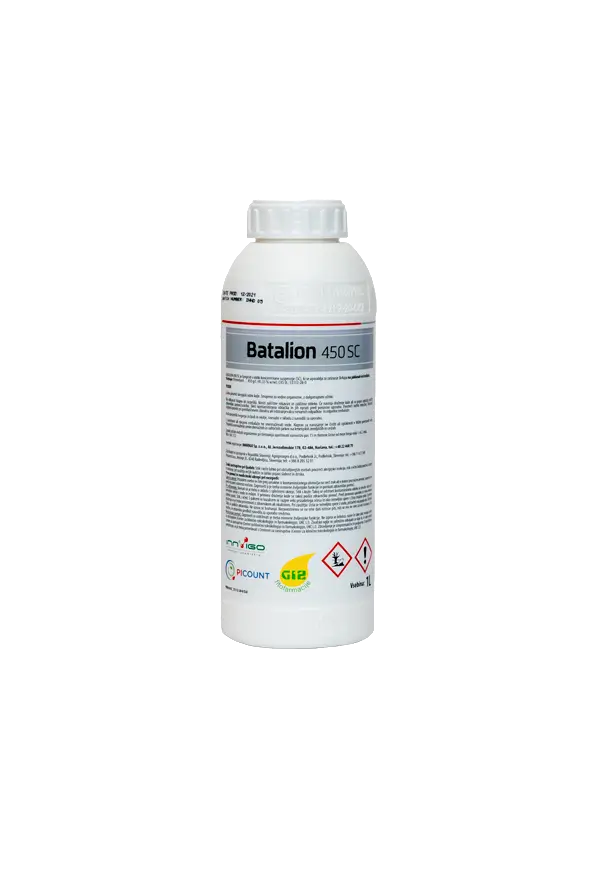
Agroblend Batalion 450SC Home Fungicide Product Information on the product Weight: 1LFormulation: Concentrated Suspension (SC)Type: Systemic fungicide with a broad spectrum of action. A systemic fungicide with a broad spectrum of action, for the control of diseases in fruit trees, vines, vegetables, and ornamental plants. It provides maximum protection against diseases, with various application methods, both preventive and curative. Please consult the technical service for advice on specific crops and conditions. Contact Now >> First aid instructions and medical advice:If you need medical advice, keep the container or label of the product on hand.In case of exposure or contact: Seek medical advice/attention. • General information: Poisoning symptoms may occur even after many hours; if symptoms appear, place the affected person under medical supervision. • In case of inhalation: Keep the person in clean air and call a doctor. If the affected person is unconscious, keep them or transport them in a side-lying position. • In case of skin contact: Wash hands thoroughly immediately with water and soap. If skin irritation persists, consult a doctor. • In case of eye contact: Rinse eyes by holding the eyelids open for several minutes with running water. Seek medical treatment. • In case of ingestion: Rinse the mouth. Do not induce vomiting; seek immediate medical help. • If necessary, show the doctor the packaging or label of the product. • No specific antidote known. Treat symptomatically. Information Additional Information Mode of Action:Batalion 450 SC is a fungicide in the form of a concentrate for preparing a water-based suspension with a surface effect, intended for preventive and curative use. PRECAUTIONARY MEASURES, WITHHOLDING PERIOD, AND SPECIAL CONDITIONS OF USE The period from the last application to harvest day (withholding period):• Apple, pear – 28 days.• Raspberry, strawberry – 3 days. It is recommended to use the agent alternately with fungicides from other chemical groups for a different mechanism of action. TO COMBAT THE FORMATION OF DISEASE RESISTANT STRAINSFungicides containing active substances from the anilinopyrimidine group (pyrimethanil, cyprodinil) should not be used more than 4 times during the growing season. PREPARATION OF THE SOLUTIONBefore preparing the solution, determine the required amount. Shake the contents of the package before use. Pour the measured amount of the agent into the partially filled sprayer tank (with the agitator running). Rinse the empty bottles three times with water and pour the rinsate into the sprayer tank along with the solution. Add water to the required amount. After pouring the product into the sprayer tank, which is not equipped with a hydraulic mixer, mix the liquid mechanically. TREATMENT OF RESIDUES AND CLEANING OF THE EQUIPMENTThe residues of the working solution after use should be treated in a manner that minimizes the risk of surface and groundwater contamination, in accordance with the provisions of the Water and Soil Pollution Law, i.e. • after dilution, it can be used on the treated area, if possible • or neutralized with the use of technical solutions ensuring the biological degradation of the product’s active substances • or disposed of in any other manner according to the provisions for waste disposal. Clean the equipment thoroughly after use.Use the same protective equipment when dealing with cleaning water for the equipment. Information Usage & Dosage Product for use with self-propelled sprayers or tractors. Apple– Venturia inaequalis.– Maximum dose for a single application: 1.0 l/ha.– Recommended dose for a single use: 0.7 – 1.0 l/ha.– Use the higher recommended doses in cases of greater disease risk.– Maximum number of treatments during the growing season: 3.– Minimum interval between treatments: at least 7 days.– Application time: Used from the visible flower bud stage to the end of the flowering phase (BBCH 55-69), preventively every 7-10 days depending on weather and signaling, or as intervention up to 72 hours after infection.– Recommended solution volume: 500 – 750 l/ha.– Recommended spraying: medium droplets. APPLICATION OF THE PRODUCT IN SMALL CROPS AND SMALL APPLICATIONSThe user is solely responsible for the effectiveness and phytotoxicity of the product used in small crops. Strawberry– Botrytis cinerea– Application time: Use the product from the beginning of the flowering phase to fruit maturation (BBCH 61-87).– Maximum recommended dose for a single use: 1.66 l/ha.– Maximum number of treatments during the growing season: 2.– Interval between treatments: at least 7 days.– Use the agent with a self-propelled garden sprayer or a tractor-type sprayer with a range of Fragaria or a fan sprayer with a directed airflow.– Recommended solution volume: 500-750 l/ha.– Recommended spraying: medium droplets. Raspberry– Botrytis cinerea, Didymella applanata– Application time: Use the product during the period of greatest disease risk when the fruit is in full bloom and after harvesting the fruit and pruning old shoots (BBCH 65-87).– Maximum recommended dose for a single use: 1.66 l/ha.– Maximum number of treatments during the growing season: 2.– Interval between treatments: at least 7 days.– Apply the agent using a fan sprayer with a directed airflow.– Recommended solution volume: 1000 l/ha.– Recommended spraying: fine droplets. Pear– Venturia pirina– Application time: Use the product from the visible flower bud phase to the end of the flowering phase (BBCH 55-69), preventively every 7 days depending on weather and signaling, or as intervention up to 72 hours after infection.– Maximum dose for a single use: 1.0 l/ha.– Recommended dose for a single use: 0.7 – 1.0 l/ha.– Use the higher recommended doses in cases of greater disease risk.– Maximum number of treatments during the growing season: 2.– Interval between treatments: at least 7 days.– Recommended solution volume: 500-750 l/ha.– Recommended spraying: medium droplets. Information Usage & Dosage CARE FOR WORKERS AND OTHERSBefore using the product, all interested parties who might be at risk from spray drift and who have requested such information should be informed.Eating, drinking, or smoking during product application is prohibited.Inhalation of the product should be avoided. Avoid skin contamination. • OPERATOR: Must wear protective gloves and protective clothing (including a hooded coverall) to protect against the effects of plant protection products, as well as appropriate footwear during the preparation
Galileo 125
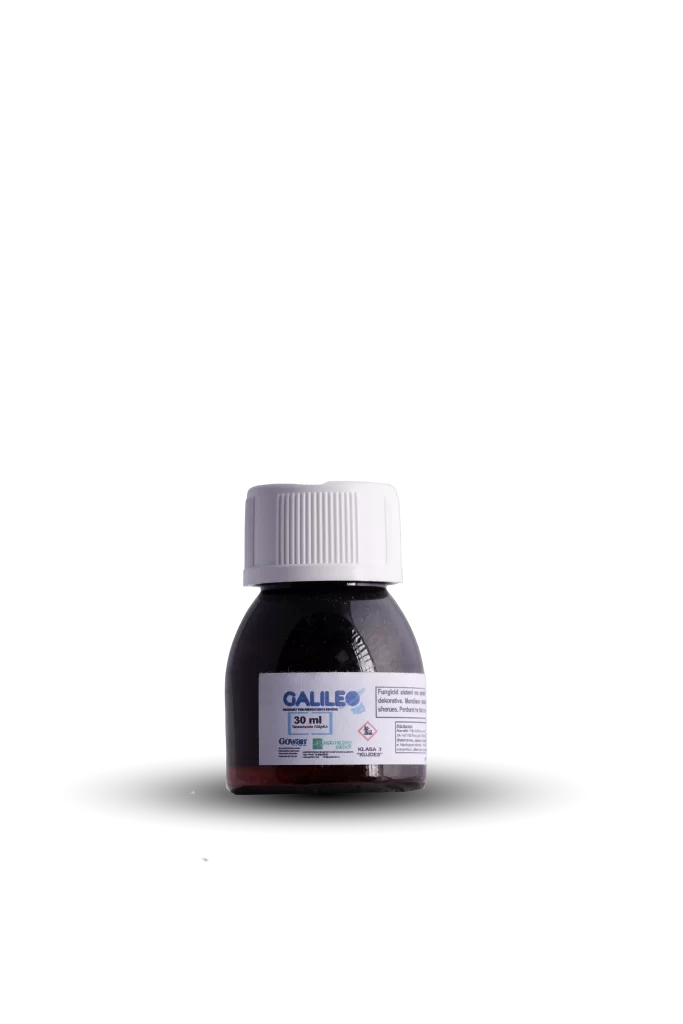
Agroblend Galileo 125 Home Fungicide Product Information on the product Formulation: Water emulsion (EW)Type: Systemic fungicide with a broad spectrum of action. GALILEO 125 EW is a systemic fungicide with a broad spectrum of action, used for controlling diseases in vineyards, fruit trees, vegetables, and ornamental plants. GALILEO 125 EW provides maximum protection against diseases, with different application methods, both preventive and curative. It is used in various vegetative phases, either alone or in combination with other products, depending on the appropriate treatment. Please consult the technical service for advice on specific crops and conditions. Contact Now >> First Aid Instructions and Medical Advice:First Aid Instructions and Advice for the Doctor: • H317: May cause an allergic skin reaction. • H361: Suspected of damaging fertility. • H373: May cause damage to organs through prolonged or repeated exposure. • EUH208: Contains spinetoram and 1.2-benzisothiazol-3(2H)-one. May cause an allergic reaction. • In case of inhalation: Move the person to fresh air. • In case of breathing cessation: Alert emergency services or an ambulance, then administer artificial respiration; to perform mouth-to-mouth respiration, the rescuer should use proper protection (e.g., a pocket mask). • In case of skin contact: Immediately remove contaminated clothing. Rinse immediately with plenty of water for 15-20 minutes. • In case of eye contact: Keep the eyes open and rinse slowly and gently with water for 15-20 minutes. • Remove contact lenses, if present, after the first 5 minutes and continue rinsing the eyes. • P101: If medical advice is needed, keep the container or product label nearby. • P308-P313: If exposed or concerned: Immediately call a poison center or a doctor. • No specific antidote. Symptomatic treatment. Information Additional Information Usage Warning:In areas with historically high infection levels, include the product in a specific pest control program. To reduce the likelihood of resistance phenomena, the product should be included in a strategy that alternates spinetoram-based and spinosad-based products with others that have different mechanisms of action. Do not perform more than two treatments per season. Strictly follow the dosages indicated on the label. Treat in the absence of wind. Phytotoxicity:When used alone, the product does not show phytotoxicity problems. Environmental Impact:– H410: Very toxic to aquatic life with long-lasting effects. Avoid contaminating water with the container or product. To protect aquatic organisms, do not use closer than 20 meters from water surfaces. Avoid cleaning equipment near water surfaces. – P273: Do not pollute the environment.– P391: Collect spillage.– P501: Dispose of the product/container in accordance with local regulations.– SP1: Do not contaminate water with the product or its container.– P501: Dispose of contents/container in accordance with legislation. Do not clean sprayers near surface waters. Avoid contamination via drainage systems. Withdrawal Period:– 3 days for citrus, cherries, and sour cherries.– 7 days for apples, pears, quinces, wild apples, medlar, peaches, nectarines, apricots, plums, figs, blueberries, persimmons, grapes, strawberries, and raspberries.– 14 days for pistachios.– 21 days for olives. Storage Conditions:Store the product in sealed containers, in dry and cool places. The storage temperature should not exceed 35°C. Do not store in direct sunlight or humidity. Information Usage & Dosage Usage:Delegate is based on spinetoram, an active ingredient derived from a bacterium (Saccharopolyspora spinosa) present in the soil and later chemically modified. It is used for controlling a wide range of pests that feed on leaves, including lepidopterans, thrips, leaf miners, and some psyllids that infest various crops. In apples, pears, quinces, medlar, persimmon, pomegranate, and figs: 2 treatments per season are allowed, with an interval of 7-14 days. Against Cydia pomonella, treat at egg hatching with 300-400 g/ha. Against Pandemis spp., Argyrotaenia pulchellana, Archips spp., Adoxophyes spp., treat when eggs hatch or against winter brood larvae with 300-400 g/ha. Against peach borer (Cydia molesta), treat near harvest time with 300-400 g/ha. Against Leucoptera scitella, Phyllonoricter spp., treat at the hatching of the first eggs with 350-400 g/ha. Against Psylla pyri, treat at the yellow egg stage with 400 g/ha. The product has a good effect against Cacopsylla melanoneura, which may be present when treating the main pests. In peaches, nectarines, apricots, plums, cherries, and sweet cherries: 2 treatments per season are allowed, with a 28-day interval. Against peach borer, Anarsia lineatella, and Cydia funebrana, treat at egg hatching with 300-400 g/ha. Against thrips (Thrips meridionalis, Thrips major, Frankliniella occidentalis), treat at the first appearance of the pest with 300-400 g/ha. Against Asian fruit fly (Drosophila suzukii), treat at the appearance of the pest with 300-400 g/ha. The product also has a good side effect against Ceratitis capitata. In olives: 2 treatments per season are allowed, with a 28-day interval. Against olive borer (Prays oleae) and (Philaenus spumarius), treat when the pest is present with 75 g/ha. In citrus: 2 treatments per season are allowed, with 300-400 g/ha, at a 7-14 day interval. Against psyllids, leaf miners, leaf curlers, and citrus thrips (Scirtothrips citri), use with 800 g/ha/season. Do not use in greenhouse citrus. In vineyards: 2 treatments per season are allowed. Against grapevine borer and thrips, treat at egg hatching with 250-300 g/ha. In pistachios: 1 treatment per season is allowed. Against Agonoscena sp., treat at the appearance of the pest with 100 g/ha. In strawberries, raspberries, blackberries, blueberries: 2 treatments per season are allowed. The doses refer to a solution of 1200-1500 liters/ha. Against Cydia pomonella, treat at egg hatching with 300-400 g/ha. Against Pandemis spp., Argyrotaenia pulchellana, Archips spp., Adoxophyes spp., treat when eggs hatch with 300-400 g/ha. Against peach borer, treat near harvest time with 300-400 g/ha. For all crops, use 1000-1500 liters of solution/ha. Information Preventive Measures • P102: Keep out of reach of children. • P103: Read the label before use. • P201: Obtain special instructions before use. • P202: Do not handle until all safety precautions have been read and understood. • P281: Use protective clothing. • P405: Store locked up. • EUH401: To avoid risks to human health and the environment, follow the instructions for use. Information Active Ingredients Active Ingredients Spinetoram
